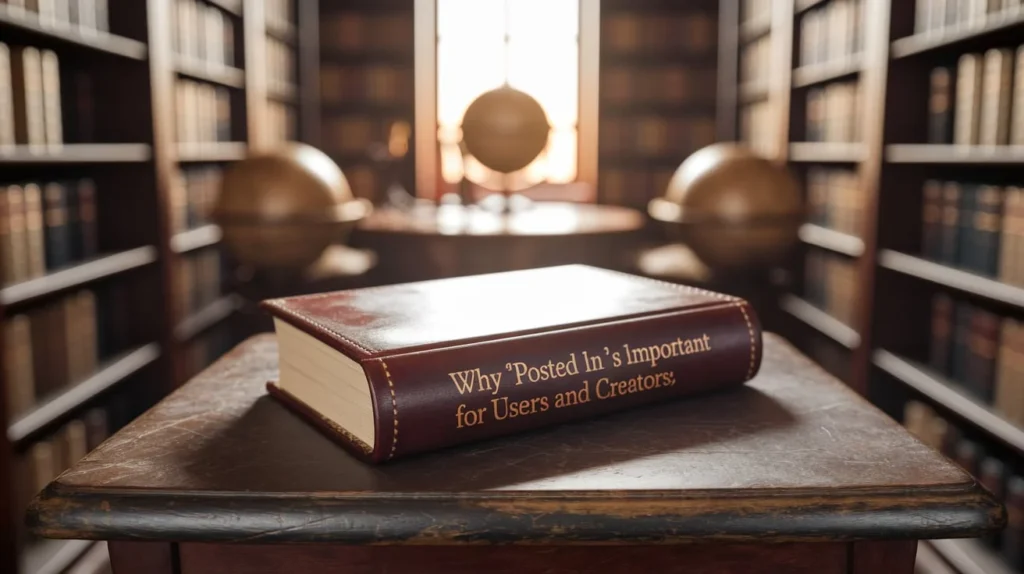In today’s digital landscape, the phrase “posted in” appears everywhere—from blogs to social media, forums to email platforms. But have you ever stopped to wonder what it really means and why it’s so important? This small phrase plays a crucial role in how content gets organized, found, and interacted with online.
In this article, we’ll explore the real essence of “posted in”, break down its common uses, explain why it matters, and share actionable tips to leverage it effectively.
Let’s dive deep into the world of “posted in” and see why it’s more than just a label.
What Does “Posted In” Mean?
At its core, “posted in” indicates the location or category where a piece of content is placed or shared within a digital platform. Unlike phrases like “posted on” (which usually refers to the platform or timeline) or “posted by” (which names the author), “posted in” pinpoints the specific group, forum, category, or tag that organizes the content.
Think of it like filing a document in a particular folder. You’re not just putting it on the desk (posted on the platform), or handing it over (posted by the author); you’re placing it inside a designated drawer or folder (posted in a category or group) so it’s easier to find and related to similar documents.
This organizational function helps both users and platforms maintain structure in the vast ocean of digital content.
Common Uses of “Posted In” Across Platforms
You’ll encounter “posted in” in several digital environments, each serving slightly different purposes:
- Blogs: Here, “posted in” often refers to the categories or tags assigned to an article. For example, a food blog post might be posted in “Vegan Recipes” or “Healthy Eating” categories. This categorization helps readers find related posts easily.
- Social Media: Platforms like Facebook or LinkedIn show “posted in” when someone shares content inside a group, event page, or community. For instance, a message posted in a Facebook group targets that community specifically, rather than the general timeline.
- Forums and Communities: In discussion boards like Reddit or specialized forums, every thread is posted in a particular subforum or subreddit. This classification keeps conversations focused and accessible.
- Email and Messaging Apps: Some apps show when an email or message is posted in a specific folder or channel, aiding organization.
Why “Posted In” Is Important for Users and Creators

Understanding why “posted in” matters goes beyond mere labeling. It carries practical value for both content consumers and producers.
For Users
- Improves Content Discovery: By grouping related content, posted in categories or groups make it easier to find similar topics. Instead of searching blindly, users can explore a focused collection of posts.
- Enhances Navigation: Clear categories reduce clutter and help users jump straight to what interests them.
For Content Creators
- Boosts SEO Performance: Search engines value well-structured content. Articles posted in relevant categories or tagged properly gain better chances of ranking high, as they’re easier to index and relate to search queries.
- Organizes Content: Creators can manage large volumes of content without chaos. It simplifies updates, archiving, and cross-referencing.
- Engages Target Audiences: Posting within specific groups or forums directs the content to the right audience, increasing interaction rates.
How “Posted In” Works Behind the Scenes
While it seems simple, the mechanics behind “posted in” involve clever content management techniques.
Content Management Systems (CMS)
Most blogging and website platforms like WordPress, Medium, and Drupal use categories and tags to implement posted in functionality.
- Categories: Broad topics that group content (e.g., “Technology,” “Travel,” “Health”).
Tags: More specific keywords related to the content (e.g., “AI,” “Backpacking Europe,” “Keto Diet”).
When you write a post, you assign it to one or multiple categories or tags. The CMS then labels the post as posted in those categories, automatically linking it with other similar posts.
Metadata and Taxonomy
Under the hood, metadata—a set of data describing your content—stores the category and tag information. This metadata guides both users navigating the site and search engines crawling the content.
Platform Examples
| Platform | Use of “Posted In” | Functionality Detail |
| WordPress | Posts posted in categories/tags | Categories for broad topics, tags for details |
| Threads posted in subreddits | Subreddit groups posts by topic | |
| Posts posted in groups or pages | Defines audience visibility and context | |
| Medium | Articles posted in publications | Groups content under thematic collections |
Practical Examples and Case Studies
Case Study 1: Blogging Success with “Posted In” Categories
A food blogger noticed that articles posted in well-defined categories like “Gluten-Free Desserts” attracted 35% more traffic than uncategorized posts. The clear categorization helped readers discover related recipes effortlessly, increasing session time and repeat visits.
Case Study 2: Facebook Group Posting
A small business posted promotions in relevant Facebook groups instead of on their timeline. This targeted approach resulted in a 50% higher engagement rate, as the posts reached a more interested audience.
Case Study 3: Forum Thread Organization
On a tech forum, users posted troubleshooting questions in specific subforums like “Laptops” or “Mobile Devices.” This precise posting made it easier for experts to find and respond quickly, improving overall community satisfaction.
How to Use “Posted In” Effectively

For those creating or sharing content, using posted in correctly can amplify your reach and improve user experience.
Best Practices for Bloggers and Website Owners
- Assign posts to clear, relevant categories — don’t overload with too many. Two or three per post is usually ideal.
- Use tags thoughtfully to capture specific themes without duplicating category names.
- Regularly review your categories and tags to avoid outdated or redundant labels.
Tips for Social Media Posting
- Choose groups or pages that align well with your content’s purpose and audience.
- Avoid spamming multiple groups with the same post; instead, tailor content to each community.
- Understand group rules about posting frequency and content type.
Avoiding Common Pitfalls
- Over-tagging: Adding too many categories or irrelevant tags can confuse users and dilute.
- Misclassification: Posting content in unrelated categories reduces discoverability and frustrates users.
Common Misunderstandings About “Posted In”
- Confusing posted in with posted on or posted by leads to misinterpretation of content location and authorship.
- Thinking more tags or categories automatically equals better SEO is false. Quality matters over quantity.
- Assuming “posted in” groups or forums are always public; some might be private, affecting visibility.
Tools and Plugins That Help Manage “Posted In” Categories
Using the right tools can make managing posted in categories easier and more effective:
| Tool/Plugin | Platform | Features |
| Yoast SEO | WordPress | Helps optimize categories and tags for SEO |
| BuddyPress | WordPress | Manages groups and community posting |
| Buffer | Social Media | Schedules posts in multiple groups/pages |
| Discourse | Forums | Organizes threads with tags and categories |
Conclusion
The phrase “posted in” might seem small, but it holds big power in the digital content world. It organizes information, guides discovery, and connects content with the right audience. Whether you’re a reader searching for specific topics or a creator looking to boost visibility and engagement, understanding and using posted in effectively is a key skill.
Next time you see posted in on a blog, forum, or social media post, remember it’s more than a label—it’s a gateway to better content experience and smarter digital navigation.

Meet Mia Rose, the heart and hands behind the whimsical wonders at PunnyPeeks. With a keen eye for detail and a passion for creative expression, Mia turns balloons into art and events into unforgettable experiences. Whether she’s styling a dreamy wedding arch or adding a playful pop to a birthday party, her work radiates joy, color, and personality.




